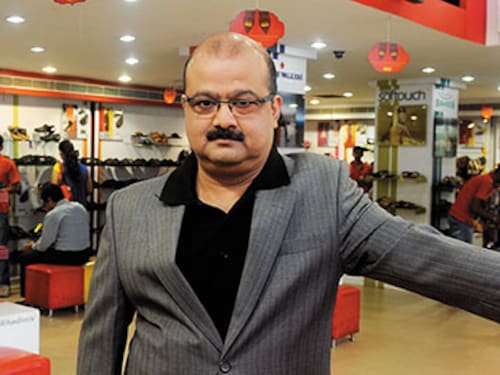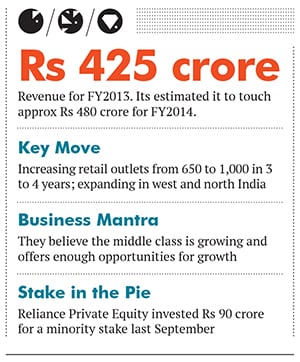Khadim India: Taking Steps Towards A National Presence
The five-decade-old Kolkata-based footwear retail chain is taking firm steps towards a strong national presence


My business is not my jaagirdaari,” says Siddhartha Roy Burman, the second-generation entrepreneur who runs Kolkata-based footwear company Khadim’s. “Why shouldn’t I be ready to part with a bit of it if it’s good for business?” Last year, Roy Burman accepted a Rs 90-crore investment from Reliance Private Equity (of the Anil Dhirubhai Ambani Group) for a “significant minority stake” in his company. Reason: His plan to expand Khadim’s across India.
Growth has been on Roy Burman’s agenda since he joined his father in 1982. In 1992, when Khadim India Ltd was still a wholesale footwear business, Roy Burman commissioned Ulka, an advertising agency, to make a short film on his firm. “I spent Rs 3.5 lakh on that film and made it just out of an emotional attachment to my business,” says Roy Burman (52). But the outcome went beyond sentimentality: Numerous interactions with brand consultants at Ulka indicated the need to build a retail brand.
In 1993, he started three Khadim’s retail outlets in Kolkata, offering an affordable range of footwear. Customers voted with their wallet and Roy Burman, thereafter, started to roll out retail operations in India’s eastern states, and later entered Tamil Nadu.
Today, with a presence in 21 states with 650 outlets (70 of which are in Kolkata), and a turnover of Rs 425 crore (FY2013), Khadim’s is a well-known brand in eastern India it is also present in parts of south and central India.
The Men Behind it
Satya Prasad Roy Burman was a rebel who had run away from his Kolkata home to Mumbai when he was 18. He returned home after having worked at a few shoe shops and, once back, bought a small store in Chitpur, owned by KM Khadim, in 1965. He soon realised the need for affordable and quality footwear and started manufacturing as well as procuring from other vendors he later expanded his wholesale business across West Bengal and eastern India.
His son Siddhartha joined him after graduating, and together they set up two manufacturing units. Satya Prasad passed away last year, but Siddhartha plans to build on his father’s legacy and has brought his two sons into the business now.
 Why It Is A Hidden Gem
Why It Is A Hidden Gem
Khadim’s understands the price-conscious consumer of middle India and offers quality footwear at affordable prices for the entire family. Having realised early enough that the Indian footwear industry (worth Rs 35,000 crore, and largely unorganised) was large enough to give rise to an organised player, Roy Burman had bet on establishing his brand. Today, he claims to have a 5 percent market share of the Rs 10,000 crore organised market.
The capital infusion from Reliance Private Equity will help double Khadim’s revenue to Rs 1,000 crore by 2017, and scale up the current 650 stores to 1,000, says Roy Burman, chairman and managing director of Khadim India Ltd. He plans to open almost 90 stores annually, of which about 35 will be company-owned while the rest will be franchised as exclusive branded outlets.
“This will help us achieve 9 percent market share of the organised footwear market in India,” adds CEO Suman Burman Roy, Siddhartha’s cousin. Apart from footwear, for which Khadim’s has around 10 sub-brands in every price bracket, the company sells leather accessories such as women’s purses, men’s wallets and school bags. Meanwhile, the wholesale trading business contributes about 20 percent to the total revenue.
Ramesh Venkat, CEO of Reliance Private Equity, is confident about his investment in Khadim’s. “It is a reputed brand in the market it operates in, has enough scope for expansion, already has a large distribution network and is catering to the expanding middle class,” he says.
It helps that Khadim’s attempt at an IPO in 2009 led to the appointment of a professional team of CEO and CFO, addition of rigour to its systems and processes, and the induction of an independent board of directors to meet the required governance standards. It is a well-oiled machine, says Roy Burman, pointing out that they now have the ability to launch a store within 15 days of finalising a location.
If the targets are met, the company plans to go public and list in three to four years, giving a profitable exit to its equity investor.
Risks and Challenges
The success of Roy Burman’s gameplan hinges on many variables. Margins and profitability need to be insulated while devising expansion plans. While turnover has increased by Rs 60 crore in the last two years, profit has remained at about Rs 10 crore.
The other concern is manpower. Given its growth targets, Khadim’s will need to hire and train people at various levels, and talent in the retail industry is scarce. Reliance on predicting trends is also a challenge: Any misstep can lead to unsold inventory and capital costs.
Though Khadim’s primarily caters to the middle class, it has taken the initial steps to enter the premium segment. This will require investments in building a brand, a fresh understanding of customers and marketing expenses.
Roy Burman is aware of all these issues and is geared up to face the road ahead. You can get a sense of his mindset by the book he is currently reading: Reimagining India by McKinsey & Company. “I am not a magician, but we are a strong team now and, with new learnings from our equity partners, we understand the national market better,” he says.
First Published: Jul 16, 2014, 06:52
Subscribe Now